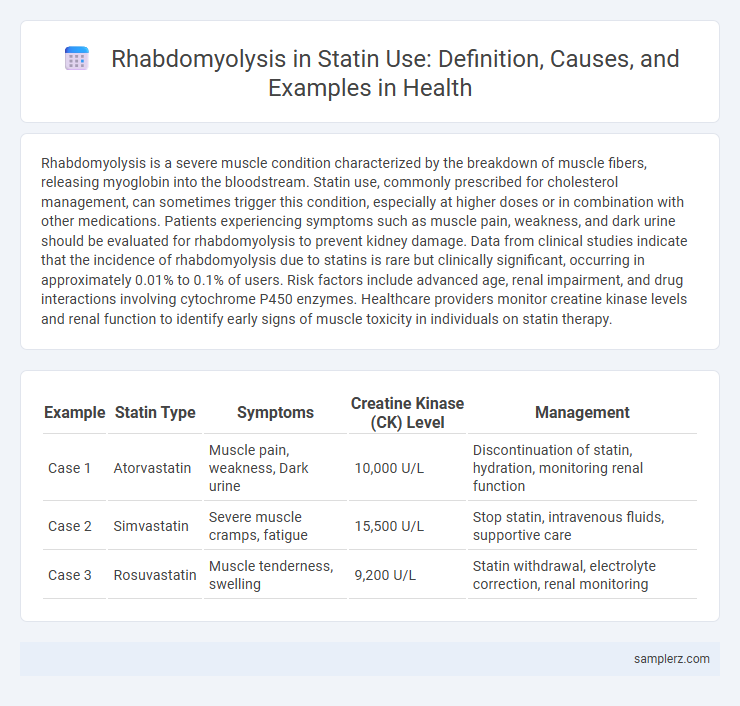Rhabdomyolysis is a severe muscle condition characterized by the breakdown of muscle fibers, releasing myoglobin into the bloodstream. Statin use, commonly prescribed for cholesterol management, can sometimes trigger this condition, especially at higher doses or in combination with other medications. Patients experiencing symptoms such as muscle pain, weakness, and dark urine should be evaluated for rhabdomyolysis to prevent kidney damage. Data from clinical studies indicate that the incidence of rhabdomyolysis due to statins is rare but clinically significant, occurring in approximately 0.01% to 0.1% of users. Risk factors include advanced age, renal impairment, and drug interactions involving cytochrome P450 enzymes. Healthcare providers monitor creatine kinase levels and renal function to identify early signs of muscle toxicity in individuals on statin therapy.
Table of Comparison
| Example | Statin Type | Symptoms | Creatine Kinase (CK) Level | Management |
|---|---|---|---|---|
| Case 1 | Atorvastatin | Muscle pain, weakness, Dark urine | 10,000 U/L | Discontinuation of statin, hydration, monitoring renal function |
| Case 2 | Simvastatin | Severe muscle cramps, fatigue | 15,500 U/L | Stop statin, intravenous fluids, supportive care |
| Case 3 | Rosuvastatin | Muscle tenderness, swelling | 9,200 U/L | Statin withdrawal, electrolyte correction, renal monitoring |
Overview of Rhabdomyolysis in Statin Therapy
Rhabdomyolysis in statin therapy is a rare but serious condition characterized by the rapid breakdown of skeletal muscle fibers leading to the release of myoglobin into the bloodstream, which can cause acute kidney injury. Clinical presentation often includes muscle pain, weakness, and elevated creatine kinase levels exceeding 10 times the upper limit of normal, necessitating prompt discontinuation of the statin and aggressive hydration. Risk factors for statin-induced rhabdomyolysis include high dosage, drug interactions, advanced age, renal impairment, and hypothyroidism.
Understanding Statin-Induced Muscle Damage
Statin-induced muscle damage, exemplified by rhabdomyolysis, manifests as severe muscle pain, weakness, and elevated creatine kinase levels resulting from muscle fiber breakdown. This condition occurs due to statins interfering with muscle cell metabolism, leading to muscle necrosis and potential kidney damage from myoglobin release. Early diagnosis and statin discontinuation are critical to preventing permanent muscle injury and renal complications.
Common Statins Linked to Rhabdomyolysis
Atorvastatin, simvastatin, and rosuvastatin are common statins frequently associated with rhabdomyolysis, a severe muscle injury marked by muscle pain, weakness, and elevated creatine kinase levels. The risk of rhabdomyolysis increases with higher doses, drug interactions, and underlying renal impairment. Early detection and discontinuation of the statin are crucial to prevent acute kidney injury and other complications.
Clinical Presentation: Signs and Symptoms
Rhabdomyolysis in statin use typically presents with muscle pain, weakness, and swelling, predominantly affecting proximal muscle groups. Patients may report dark, cola-colored urine due to myoglobinuria, indicating muscle breakdown and potential kidney involvement. Elevated creatine kinase (CK) levels are a key diagnostic marker, often exceeding 10 times the upper limit of normal.
Case Studies: Real-Life Examples
A 58-year-old male on atorvastatin for hyperlipidemia developed severe muscle pain and dark urine after intense physical activity, with lab tests confirming elevated creatine kinase levels indicative of rhabdomyolysis. Another case involved a 65-year-old female taking simvastatin who presented with acute renal failure secondary to muscle breakdown, highlighting the risk of statin-induced myopathy. These instances emphasize the importance of monitoring symptoms and laboratory markers in patients receiving statin therapy.
High-Risk Populations for Statin Myopathy
Elderly patients, individuals with pre-existing renal impairment, and those on high-dose statin therapy are at increased risk for rhabdomyolysis, a severe form of statin-induced myopathy characterized by muscle breakdown and elevated creatine kinase levels. Co-administration of medications such as fibrates or cyclosporine further elevates this risk by altering statin metabolism via cytochrome P450 pathways. Genetic factors, including variants in the SLCO1B1 gene, significantly predispose patients to statin-induced muscle toxicity, necessitating careful monitoring and dose adjustments in these high-risk populations.
Diagnostic Criteria for Rhabdomyolysis
Rhabdomyolysis in statin use is diagnosed by elevated serum creatine kinase (CK) levels exceeding five times the upper limit of normal, often accompanied by muscle pain or weakness. Urinalysis may reveal myoglobinuria, presenting as dark, tea-colored urine, indicative of muscle breakdown. Early detection through these diagnostic criteria is crucial to prevent acute kidney injury associated with statin-induced rhabdomyolysis.
Management Strategies for Affected Patients
Rhabdomyolysis induced by statin use requires immediate discontinuation of the statin and aggressive hydration with intravenous fluids to prevent acute kidney injury. Monitoring of creatine kinase (CK) levels, renal function, and electrolyte balance is essential to assess severity and guide treatment adjustments. In severe cases, renal replacement therapy may be necessary, and alternative lipid-lowering therapies should be considered to manage cardiovascular risk without exacerbating muscle toxicity.
Preventive Measures During Statin Treatment
Regular monitoring of creatine kinase levels and liver function tests is essential to detect early signs of rhabdomyolysis in patients on statin therapy. Patients should be advised to report muscle pain, weakness, or dark urine promptly to prevent severe complications. Adjusting statin dosage and avoiding drug interactions can significantly reduce the risk of muscle toxicity during treatment.
Key Takeaways and Patient Education
Rhabdomyolysis is a rare but serious side effect of statin use, characterized by muscle pain, weakness, and dark urine due to muscle breakdown releasing myoglobin into the bloodstream, which can lead to acute kidney injury. Key takeaways include early recognition of symptoms, prompt discontinuation of statins, and immediate medical evaluation to prevent complications. Patient education should emphasize reporting unexplained muscle pain or weakness and maintaining hydration to support kidney function during treatment.

example of rhabdomyolysis in statin use Infographic
 samplerz.com
samplerz.com